
When NVMe™ drives first came out, we knew the performance would be superior, but questioned when they would be cost-comparable to SATA SSDs. Due to their initial cost, NVMe drives were used for enterprise applications that needed to take advantage of their high-performance characteristics. It didn’t take very long for NVMe drives to become cheaper than SATA/SAS SSDs in terms of dollars-per-IOPS. But now, we are starting to reach the point where they are not that much more expensive than SATA/SAS SSDs on a capacity basis. This GB vs. dollar comparison was driven home to us when we received the Western Digital Ultrastar® DC SN640 NVMe SSD in the lab for performance testing – it offers dramatic performance improvements over SATA/SAS SSDs and targets the mainstream enterprise storage market. Now that NVMe SSDs are near cost parity, we see them as a replacement for SATA drives in the data center for mainstream applications as they offer better performance while having lower power requirements.
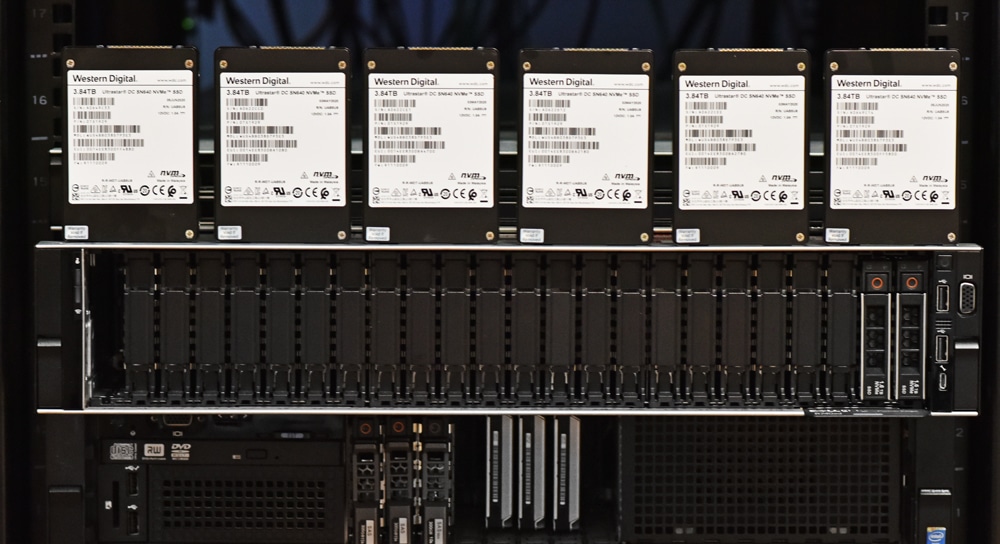
Before digging into the specifics of the Ultrastar SN640, and giving an overview of the performance testing that we did on it, let’s first take a look at Western Digital’s background with, and current lineup of, Flash storage, as well as the technology behind the SN640 that makes it such an attractive replacement to SATA/SAS drives.
Founded in 1970, Western Digital has a rich history of developing and working with semiconductors. They first produced discrete components such as the chips that fueled the electrical calculator revolution of the mid-1970s, and then the control chips for disk drives; from this background, they logically migrated to producing entire hard drives. In the 1990s and the early part of the 2000s, they created many innovations that improved the performance and capacity of their drives.
Throughout the years, Western Digital worked with SanDisk® on Flash products, and in 2016 it acquired them.SanDisk was an early innovator in Flash storage and proved over time to be a true innovator in the storage market. In 1988, they introduced System Flash for computer storage and worked with Western Digital in the 1990s to create the first commercial Flash SSD product. Over time, SanDisk has proven to be a true innovator in the storage market; they shipped the world’s first commercial NANDS MLC 1GB chips, as well as jointly developed microSD™ cards, Flash memory cards with 64GB X4 (4 bits per cell) NAND Flash technology, and other technologies that pushed Flash forward, not only from a technology and performance standpoint but also from a cost standpoint.
Drawing upon this rich history, Western Digital has developed a swath of products to meet the specific requirements of both commercial and enterprise users alike and has used different brands to meet the needs of different markets with unique product offerings. For instance, the SanDisk brand is focused on mobile storage products, and the G-Technology® brand is focused on drives and storage systems designed for creative professionals.
Under the Western Digital brand, they offer HDD and Flash drives, and storage solutions for personal and enterprise use. To help users select the drive that best suits their needs, Western Digital divides some of their drives into color-coded classifications: WD Green drives are for everyday computing needs in your PC, WD Blue drives are for desktop use, WD Purple drives are for surveillance storage, WD Red drives are geared toward network-attached storage, and their WD Black and WD Gold drives are their high-performance gaming and enterprise drives respectfully. These last two color categories come with a five-year limited warranty, while the others come with a three-year limited warranty. Western Digital does not offer HDD, SATA, SAS, or NVMe devices in all their colors, but they do offer the most appropriate storage technology for a given use case.
For enterprise and data center customers, Western Digital has a line of Ultrastar drives. They prefix their drives with a two-character code to indicate the type of device: HC are HDD devices, SS are SAS drives, SN are NVMe drives, SA are SA SATA drives, and ME are memory extension drives.

The drive that we will be looking at in this article is the Western Digital Ultrastar DC SN640 NVMe SSD. It is the successor to the Ultrastar DC SN630 with key improvements in performance. Both drives use Western Digital’s in-house NVMe controllers with their own NAND and firmware which provide massive optimizations leading to consistent low latencies and high performance. These drives are for mainstream designs, which is the drive that Western Digital markets as a transitional drive to get enterprise customers away from last-gen SATA/SAS Flash storage technologies and into current NVMe Flash storage. Western Digital makes available in smaller quantities for distribution and e-tailers, the WD Gold NVMe SSD which has many of the same capabilities of the Ultrastar SN640. Worth noting that Western Digital also offers the Ultrastar DC SN840 NVMe SSD aimed at AFAs running mission-critical workloads and HPC servers. We look forward to getting our hands on this product.
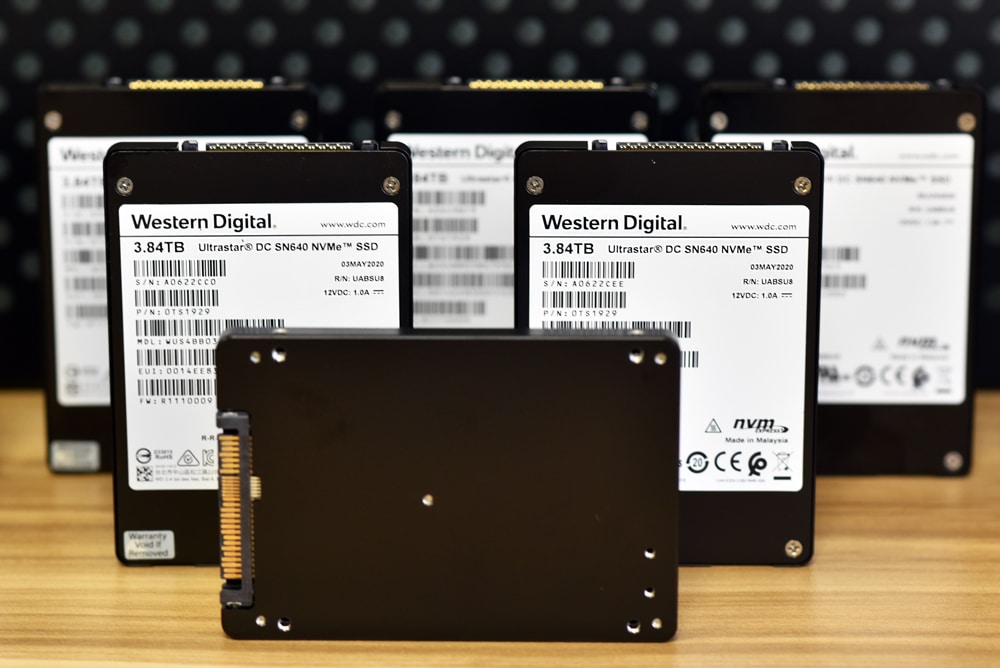
The SN640 line of NVMe drives are 2.5” x 7mm in size with a U.2 connector and contain storage capacity ranging from 800GB to 7.68TB. Because these drives were designed for enterprise and data center use, they come with a five-year limited warranty, have a mean time between failure (MTBF) rating of 2 million hours, are rated at 0.8 or 2.0 DWPD, and have Secure Erase (SE) Instant Secure Erase (ISE) or TCG Ruby security options. To enhance performance, SN drives use Western Digital’s own PCIe Gen 3.1 x 4 (NVMe 1.3) controller. Furthermore, to make them cost-competitive with SATA/SAS SSD drives, they use Western Digital’s 96-layer BiCS4 3D TLC NAND. Western Digital has rated these drives at up to 515K IOPs random reads, and claims they offer five times the read performance while using 65% less IOP/Watt than SATA drives.
Western Digital Ultrastar DC SN640 NVMe SSD specifications:
- Form factor: 2 2.5”, 7mm
- Capacity: 800GB to 7,680GB
- NAND: Western Digital BiCS4 3D TLC NAND
- Interface: PCIe Gen3 x4 (Compliant to NVMe 1.3c)
- Performance: (TCG Ruby model)
- Sequential Read Performance (Up to): 3340 MB/s
- Sequential Write Performance (Up to): 2190 MB/s
- Random 4KiB Read (Up to): 515K IOPS
- Random 4KiB Write (Up to): 161K IOPS
- Random 70/30 Read/Write, 4KiB (Up to): 305K IOPS
- Read Latency (down to): 78 us
- Endurance and Reliability:
- DW/D: 0.8 (read-intensive), 2 (mixed-use)
- Uncorrectable Bit Error Rate (UBER): 1 in 10 to the 17th
- MTBF: 2 M hours
- Power Loss Protection (PLP) and end-to-end data path protection
- Features
- 128 NVMe Namespace Support
- Variable Sector Size Support
- NVMe-MI 1.1 (TCG Ruby model)
- Secure Erase, Instant Secure Erase, and TCG Ruby
- Environment:
- Operating Power State (max): 12W
- Idle Power State (typical): < 5W
- Operating Temperature: 0 to 70 °C ambient temperature with suggested airflow
- Non-Operating Temperature: -40° to 85° C
- 5-year limited warranty
NVMe drives have been in the enterprise market for a while now, and the biggest blocker to their widespread utilization has traditionally been their cost, but this is no longer the case. The street price of an SN640 with a capacity of 7.68TB is $1,400, and a comparable SATA SSD comes in at $1,200. A lower-capacity drive, such as the SN640 960GB, comes in at $300, while a comparable datacenter-rated SATA SSD drive is priced at $260. In other words – for about a 16% increase in price, you get a far more performant drive. By switching to NVMe drives servers can handle modern workloads which demand fast response times. SATA drives, with their limited bandwidth and much higher latencies, cannot efficiently handle the demanding storage requirements of today’s applications.
Due to their high price, NVMe drives were relegated to niche use cases when they were initially released. Now, however, newer NVMe SSDs like the SN640 have become a storage solution for mainstream workloads, such as backing for virtual machines (VMs), serving as the Flash cache for software-defined storage (SDS), and even acting as boot devices. The one drawback that we currently believe is impeding their more widespread adoption is that servers are still struggling to catch up with them, and not all servers can support the number of NVMe ports that people would like to populate them with. If this is indeed the case, then server architects need to use this valuable resource judicially (not from a cost standpoint, but from a performance standpoint) and make sure that their performance is used as wisely as possible.
Test Data
To measure the performance of the Western Digital Ultrastar DC SN640 NVMe SSDs, we used an industry-standard Dell EMC PowerEdge R740xd server equipped with an NVMe-compatible backplane. This server configuration offered 12 NVMe bays, from which we used 8 slots.
Test Environment:
- 8x Western Digital Ultrastar DC SN640 NVMe SSDs
- 8x Western Digital Ultrastar SA210 SATA SSDs
- Dell EMC PowerEdge R740xd server with 12x NVMe slots (8 used)
- CPU 2 x Intel® Scalable Platinum 8280
- DRAM 12 x 32GB DDR4-2933MHz
The benchmarks we focused on were synthetic workloads, which look at stressing the drives into showing their peak bandwidth or throughput numbers, as well as application workloads which show more real-world figures on what users can expect. Of these two areas, our application workloads are geared to put a better lens on latency performance. For these tests, we use a CentOS 7 environment with VDBench installed for the synthetic section and VMware ESXi™ 6.7u3 for our SQL Server and MySQL™ Sysbench VMs.
To get a better appreciation of how these NVMe drives compare to SATA SSDs, we ran tests on Western Digital Ultrastar DC SA210 1.92TB SATA drives and compared them with the 3.84TB SN640.
The chart below shows that in every category the Western Digital SN640 trounced the SATA drive by a wide margin. This ranged from a 46% improvement in our Sysbench average latency to an outstanding 875% improvement during our 4K 70/30 random IOPS testing.
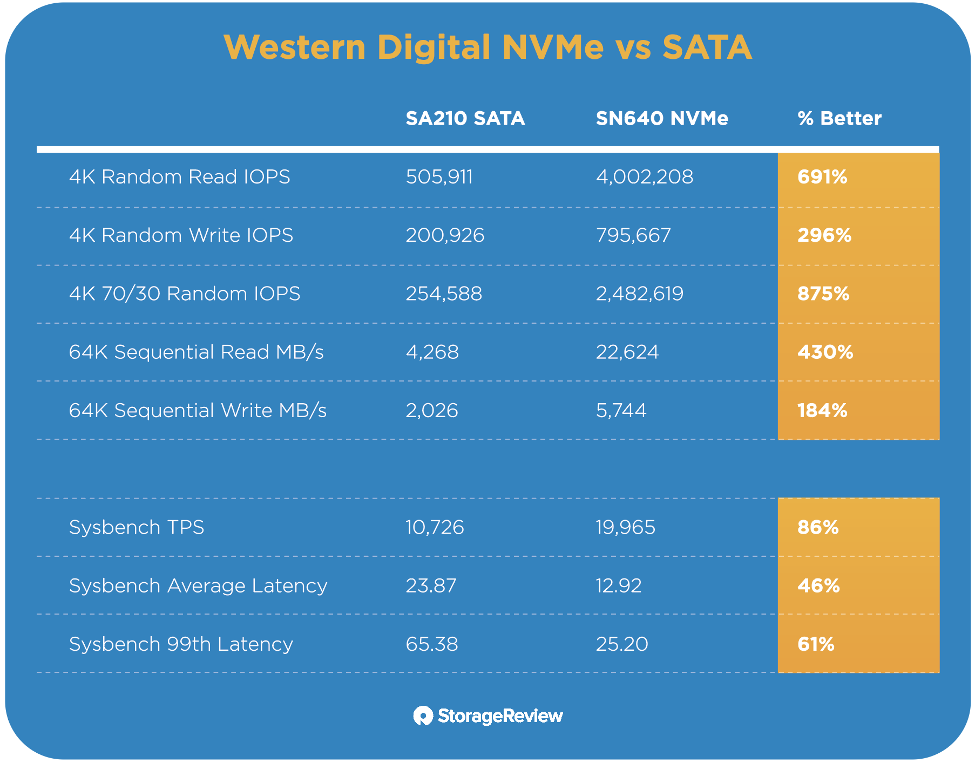
The raw performance numbers were very impressive, but we wanted to get a feel for how this would translate to real-world conditions. We first looked at how well the drives could handle a VDI Monday morning boot storm.
The SATA drive’s latency degraded rapidly to the point where it took ~3 milliseconds to respond while the SN640 soldiered on with a gradual rise in latency up to just over 500 microseconds until we stopped the testing at slightly over 150,000 IOPS.
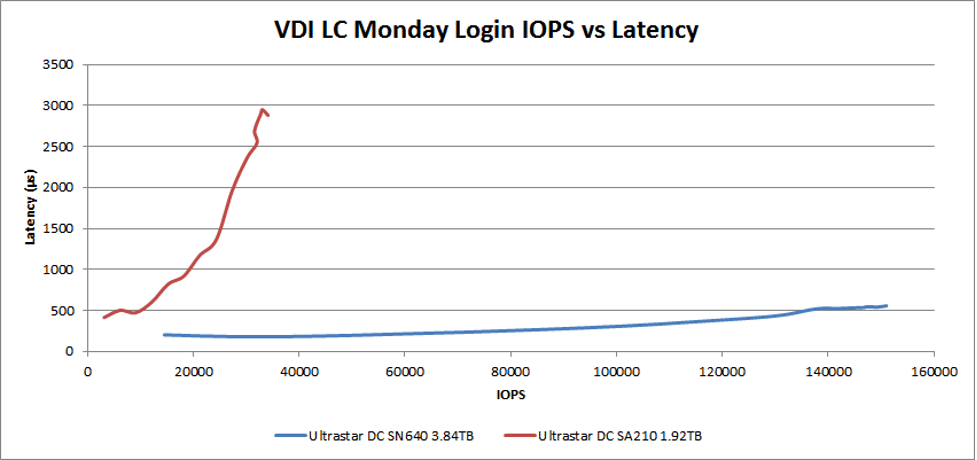
We then ran our initial login testing and again the SATA drive quickly ran out of steam while the Western Digital SN640 showed only a slight increase in latency through the duration of our testing.
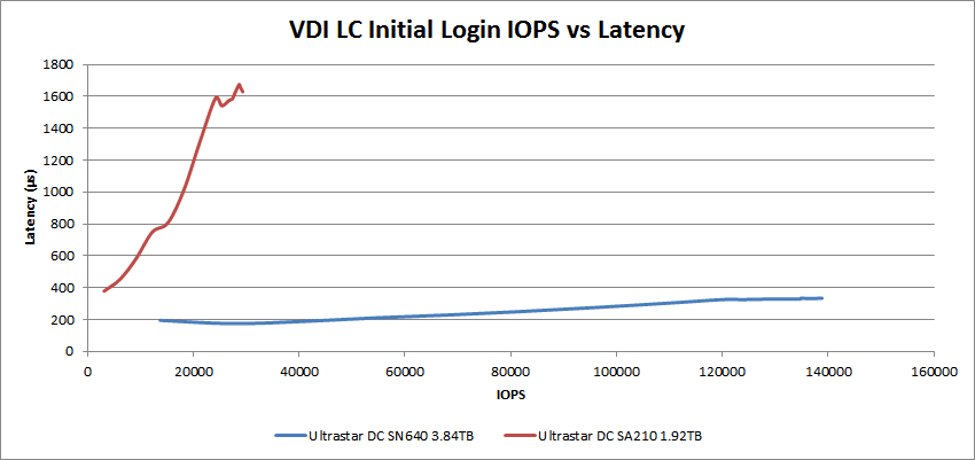
For our final real-world test, we ran an 80/20 random read/write test on the drives. Again the SATA drives peaked early, while the SN640 was able to deliver outstanding performance through a wide range of IOPS.
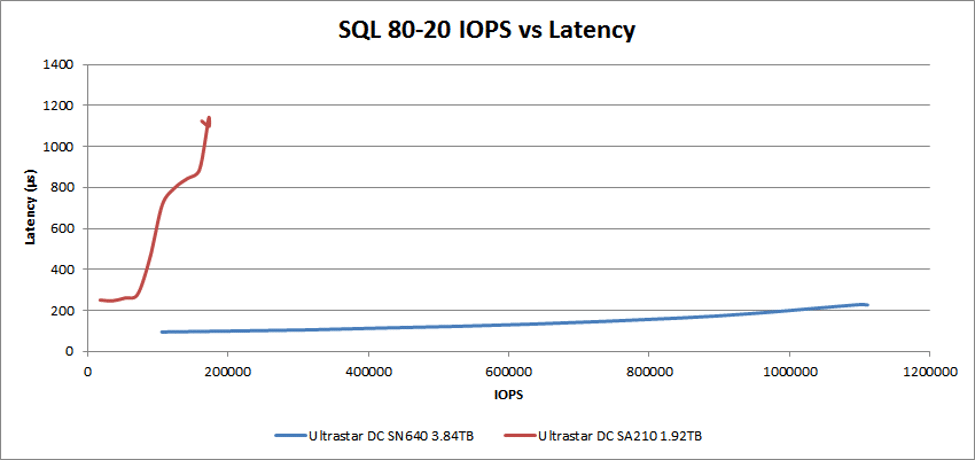
Not only did the SN640 show outstandingly low latency that had a small, gradual predictably rise in it as it was stressed by the number of IOPS, but the drive also provided consistent quality of service during our testing.
Conclusion
Our testing on the Ultrastar DC SN640 confirmed that Western Digital—using its latest in-house controller, 96L flash, and firmware—has delivered a mainstream NVMe SSD which balances performance and power for a cost-effective solution to displace SATA once and for all. NVMe drives quickly achieved parity in cost per IOPS and we predicted that there would be an inflection point where they would be cost-competitive on a capacity basis in the future, and we are now at that point. In a casual price comparison, we found that there was only a slight uplift in the price of the SN640 over SATA/SAS SSDs on a per GB basis. When viewed through the performance lens as illustrated above, there’s simply no reason to be using SATA SSDs for data storage.
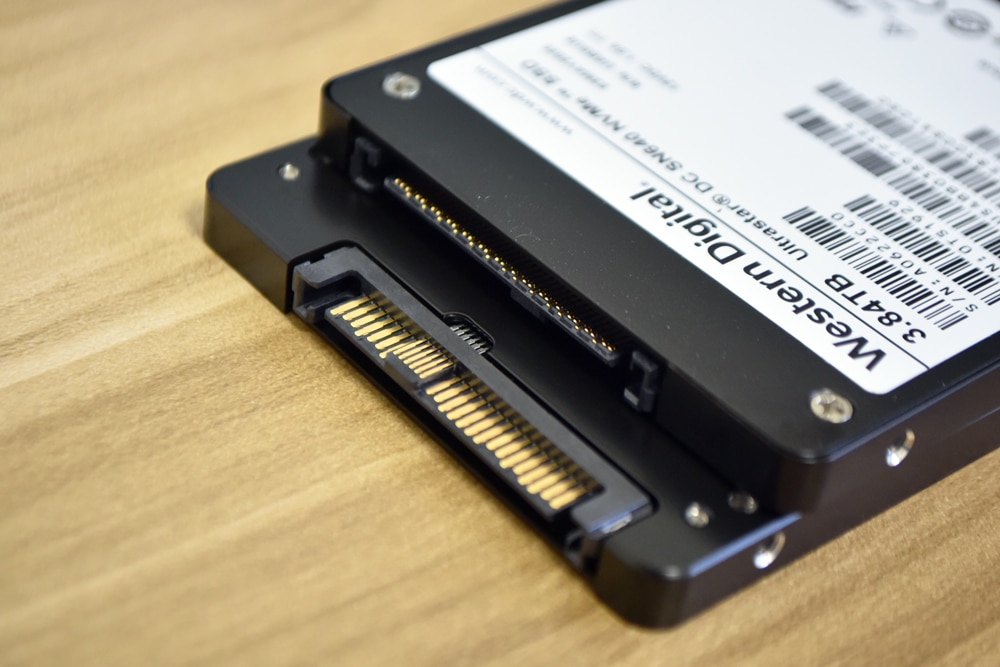
Western Digital has long been an innovator in, and at the forefront of, storage technology – and this achievement extends to flash drives. Western Digital’s relentless innovation can be seen in their SN640 line of drives where they were able to use their technical prowess to not only extract superior performance from the device but to do so at a very attractive price point.
The Ultrastar SN640 serves as a great gateway drive to get users off prior-generation storage and onto NVMe-based flash. The data clearly shows that NVMe is the path forward when it comes to providing responsive performance to the diverse set of workloads in the data center. Not only will NVMe drives increase the performance of current workloads, such as databases and virtualized workloads, but they position the data center for the more demanding next-gen workloads that are starting to appear, such as machine learning (ML) and artificial intelligence (AI), which require storage solutions with ultra-low latency and ultra-high bandwidth.




 Amazon
Amazon